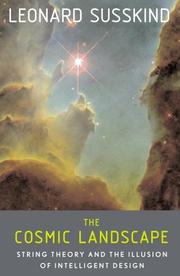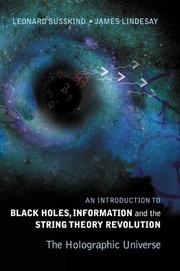| Listing 1 - 10 of 21 | << page >> |
Sort by
|
Book
ISBN: 3030451097 3030451089 Year: 2020 Publisher: Cham : Springer International Publishing : Imprint: Springer,
Abstract | Keywords | Export | Availability | Bookmark
 Loading...
Loading...Choose an application
- Reference Manager
- EndNote
- RefWorks (Direct export to RefWorks)
These three lectures cover a certain aspect of complexity and black holes, namely the relation to the second law of thermodynamics. The first lecture describes the meaning of quantum complexity, the analogy between entropy and complexity, and the second law of complexity. Lecture two reviews the connection between the second law of complexity and the interior of black holes. Prof. L. Susskind discusses how firewalls are related to periods of non-increasing complexity which typically only occur after an exponentially long time. The final lecture is about the thermodynamics of complexity, and “uncomplexity” as a resource for doing computational work. The author explains the remarkable power of “one clean qubit,” in both computational terms and in space-time terms. This book is intended for graduate students and researchers who want to take the first steps towards the mysteries of black holes and their complexity.
Black holes (Astronomy) --- Thermodynamics --- Mathematical models. --- Simulation methods. --- Chemistry, Physical and theoretical --- Dynamics --- Mechanics --- Physics --- Heat --- Heat-engines --- Quantum theory --- Frozen stars --- Compact objects (Astronomy) --- Gravitational collapse --- Stars --- Quantum field theory. --- String theory. --- Astrophysics. --- Mathematical physics. --- Cosmology. --- Thermodynamics. --- Physics. --- Gravitation. --- Quantum Field Theories, String Theory. --- Theoretical Astrophysics. --- Applications of Graph Theory and Complex Networks. --- Classical and Quantum Gravitation, Relativity Theory. --- Field theory (Physics) --- Matter --- Antigravity --- Centrifugal force --- Relativity (Physics) --- Natural philosophy --- Philosophy, Natural --- Physical sciences --- Astronomy --- Deism --- Metaphysics --- Physical mathematics --- Astronomical physics --- Cosmic physics --- Models, String --- String theory --- Nuclear reactions --- Relativistic quantum field theory --- Properties --- Mathematics

ISBN: 0316155799 Year: 2005 Publisher: New York : Little, Brown and Co.,
Abstract | Keywords | Export | Availability | Bookmark
 Loading...
Loading...Choose an application
- Reference Manager
- EndNote
- RefWorks (Direct export to RefWorks)
Astrophysics. --- Cosmogony. --- Intelligent design (Teleology). --- String models.
Multi
ISBN: 9783030451097 Year: 2020 Publisher: Cham Springer International Publishing
Abstract | Keywords | Export | Availability | Bookmark
 Loading...
Loading...Choose an application
- Reference Manager
- EndNote
- RefWorks (Direct export to RefWorks)
These three lectures cover a certain aspect of complexity and black holes, namely the relation to the second law of thermodynamics. The first lecture describes the meaning of quantum complexity, the analogy between entropy and complexity, and the second law of complexity. Lecture two reviews the connection between the second law of complexity and the interior of black holes. Prof. L. Susskind discusses how firewalls are related to periods of non-increasing complexity which typically only occur after an exponentially long time. The final lecture is about the thermodynamics of complexity, and “uncomplexity” as a resource for doing computational work. The author explains the remarkable power of “one clean qubit,” in both computational terms and in space-time terms. This book is intended for graduate students and researchers who want to take the first steps towards the mysteries of black holes and their complexity.
Cosmology --- Astrophysics --- Mathematical physics --- Quantum mechanics. Quantumfield theory --- Thermodynamics --- Physics --- Geophysics --- zwaartekracht --- thermodynamica --- astrofysica --- wiskunde --- fysica --- kosmologie
Book
ISBN: 9782070355723 Year: 2008 Volume: 510 Publisher: Paris : Gallimard,
Abstract | Keywords | Export | Availability | Bookmark
 Loading...
Loading...Choose an application
- Reference Manager
- EndNote
- RefWorks (Direct export to RefWorks)
Au regard des lois de la physique, la probabilité pour l'homme d'exister est quasi nulle. Selon L. Susskind, il existe des millions d'autres environnements dans l'univers, différents du nôtre, avec leurs propres lois de la physique.
Cosmology --- Plurality of worlds --- Astrophysics --- Cosmologie --- Pluralité des mondes --- Astrophysique
Book
ISBN: 9782070443147 Year: 2012 Publisher: Paris : Gallimard,
Abstract | Keywords | Export | Availability | Bookmark
 Loading...
Loading...Choose an application
- Reference Manager
- EndNote
- RefWorks (Direct export to RefWorks)
A mind-bending book about modern physics, quantum mechanics, the fate of stars and the deep mysteries of black holes. What happens when something is sucked into a black hole? Does it disappear? Three decades ago, a young physicist named Stephen Hawking claimed it did--and in doing so put at risk everything we know about physics and the fundamental laws of the universe. Most scientists didn?t recognize the import of Hawking?s claims, but Leonard Susskind and Gerard t?Hooft realized the threat, and responded with a counterattack that changed the course of physics. This is the story of their united effort to reconcile Hawking?s revolutionary theories with their own sense of reality--effort that would eventually result in Hawking admitting he was wrong, paying up, and Susskind and t?Hooft realizing that our world is a hologram projected from the outer boundaries of space.--From publisher description.
Quantum theory. --- General relativity (Physics) --- Black holes (Astronomy) --- Space and time. --- Théorie quantique --- Relativité générale (Physique) --- Trous noirs (Astronomie) --- Espace et temps --- Hawking, Stephen,
Book
ISBN: 9780141999869 0141999861 Year: 2024 Publisher: London : Penguin Books.
Abstract | Keywords | Export | Availability | Bookmark
 Loading...
Loading...Choose an application
- Reference Manager
- EndNote
- RefWorks (Direct export to RefWorks)
The latest volume in The New York Times bestselling physics series explains Einstein's masterpiece: the general theory of relativityHe taught us classical mechanics, quantum mechanics and special relativity. Now, physicist Leonard Susskind, assisted by a new collaborator, Andre Cabannes, returns to tackle Einstein's general theory of relativity. Starting from the equiv[Bokinfo].

ISBN: 9789812561312 9789812560834 9812561315 9812560831 Year: 2006 Publisher: Hackensack (N.J.): World scientific,
Abstract | Keywords | Export | Availability | Bookmark
 Loading...
Loading...Choose an application
- Reference Manager
- EndNote
- RefWorks (Direct export to RefWorks)
Black holes (Astronomy) --- Holography --- String models --- Trous noirs (Astronomie) --- Holographie --- Modèles des cordes vibrantes (Physique nucléaire) --- 524.8 --- The Universe. Metagalaxy. Cosmology --- Holography. --- String models. --- Black holes (Astronomy). --- 524.8 The Universe. Metagalaxy. Cosmology --- Modèles des cordes vibrantes (Physique nucléaire) --- Astronomy --- Optics. Quantum optics --- Evolution. Phylogeny --- Elementary particles --- Models, String --- String theory --- Nuclear reactions --- Laser photography --- Lensless photography --- Photography, Lensless --- Wavefront reconstruction imaging --- Diffraction --- Holographic interferometry --- Interference (Light) --- Interferometry --- Laser recording --- Photonics --- Speckle metrology --- Three-dimensional display systems --- Frozen stars --- Compact objects (Astronomy) --- Gravitational collapse --- Stars --- Space research
Book
ISBN: 9780465036677 9780465080618 Year: 2014 Publisher: New York City, NY : Basic Books,
Abstract | Keywords | Export | Availability | Bookmark
 Loading...
Loading...Choose an application
- Reference Manager
- EndNote
- RefWorks (Direct export to RefWorks)
530.1 --- Basic principles of physics --- 530.1 Basic principles of physics --- Quantum theory
Book
ISBN: 9780465093342 9780465093359 0465093345 Year: 2017 Publisher: New York : Basic books,
Abstract | Keywords | Export | Availability | Bookmark
 Loading...
Loading...Choose an application
- Reference Manager
- EndNote
- RefWorks (Direct export to RefWorks)
After teaching us classical mechanics and quantum mechanics, physicist Leonard Susskind and data engineer Art Friedman are back. This time, they introduce readers to Einstein's special relativity and Maxwell's classical field theory. Using their typical brand of real math; enlightening drawings; and the same fictional counterparts, Art and Lenny, that led us through Quantum Mechanics, Susskind and Friedman walk us through the complexities of waves, forces, and particles by exploring special relativity and electromagnetism. It's a must-read for both devotees of the series and any armchair physicist who wants to deepen their knowledge of physics' deepest truths.
Field theory (Physics) --- Special relativity (Physics) --- Relativité restreinte (physique) --- Champs, Théorie des (physique) --- Study and teaching (Higher) --- Etude et enseignement (supérieur) --- Relativité restreinte (physique) --- Champs, Théorie des (physique) --- Etude et enseignement (supérieur) --- Étude et enseignement (supérieur) --- Étude et enseignement (supérieur)
Book
ISBN: 9780141977812 Year: 2014 Publisher: London : Penguin Books,
Abstract | Keywords | Export | Availability | Bookmark
 Loading...
Loading...Choose an application
- Reference Manager
- EndNote
- RefWorks (Direct export to RefWorks)
Quantum theory --- Quantum mechanics. Quantumfield theory --- Théorie quantique. --- Théorie quantique.
| Listing 1 - 10 of 21 | << page >> |
Sort by
|

 Search
Search Feedback
Feedback About UniCat
About UniCat  Help
Help News
News